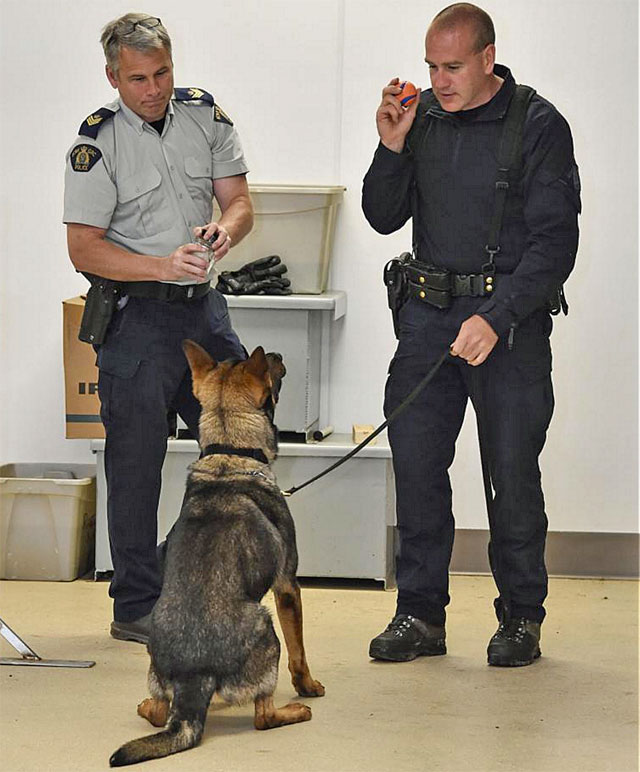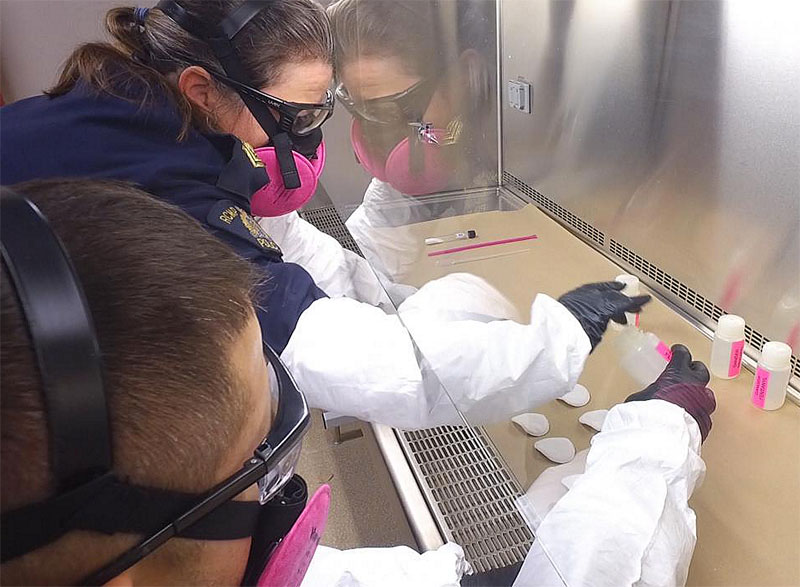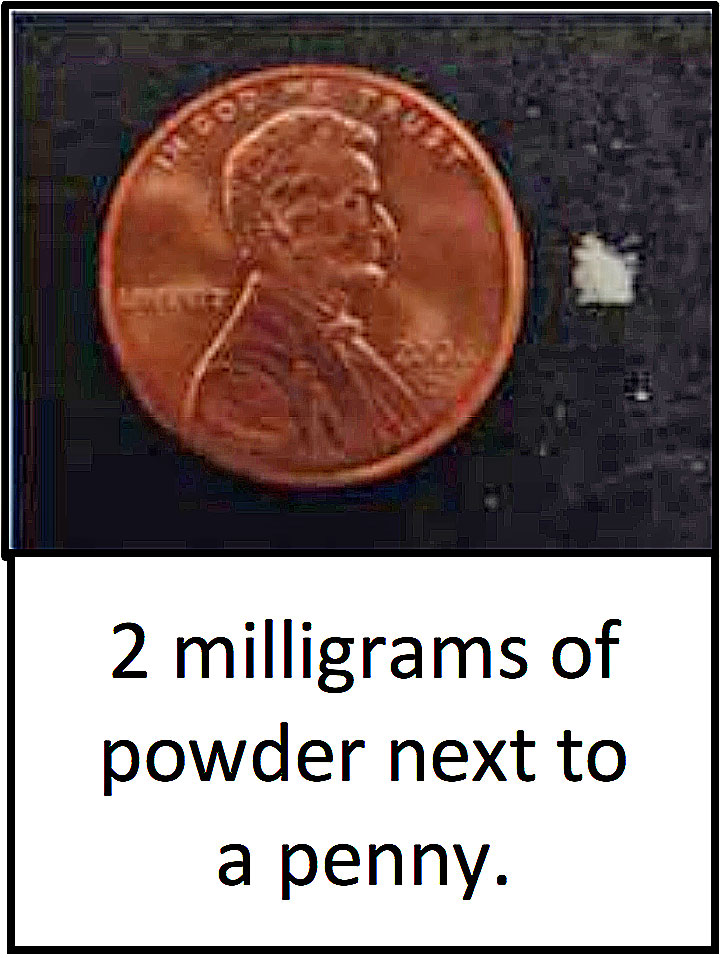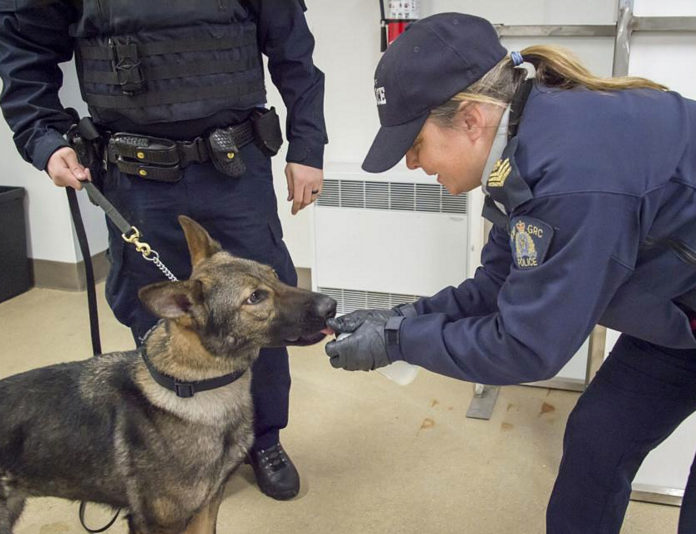To counter the presence of illicit fentanyl in Canada and to keep Canadians safe, the RCMP is currently training its Police Service Dogs to detect fentanyl.
The efforts of our neighbors to the North can only benefit the US and strengthen our combined efforts along our northern border.

And their training is paying off.
One of the three RCMP dog teams presently trained to detect fentanyl has already intercepted 12,000 tablets in B.C.
“I do believe the Canadian population is safer because of our new fentanyl dog training.”
“By keeping more fentanyl off the street, we save Canadian lives,” says Inspector Akrum Ghadban, Officer in Charge of the RCMP Police Dog Service Training Centre (PDSTC) in Innisfail, Alberta.
The RCMP leads the way in dog training to detect fentanyl. “Our specialists have transformed pure fentanyl into a diluted liquid form, enabling our dogs to train with the real smell of fentanyl with no risk of inhaling it.
It is particularly efficient, making the dogs in the field extremely productive,” says Staff Sergeant Eric Stebenne, Senior Trainer at the RCMP PDSTC.
The training of all 139 RCMP narcotics profile dog teams across Canada is expected to be completed by mid-July 2017.
(See the process of diluting fentanyl into liquid form to be used safely, for RCMP Police Service Dog training to detect fentanyl. Courtesy of RCMP and YouTube)
Fentanyl is an opioid about 100 times more toxic than morphine which can cause serious harm, including death. It has been used in tablets made to look like prescription drugs.
In September 2016, the RCMP released a video that highlights some of the dangers fentanyl and other opioids pose to first responders and the public.
Featuring real life accounts of RCMP officers who came into contact with fentanyl while on duty, it is a sober reminder that anyone can be affected by this drug without even using it.
(Learn More, courtesy of the Royal Canadian Mounted Police and YouTube)
“The danger this drug presents to all Canadians cannot be overstated,” says Bob Paulson, RCMP Commissioner.
“It’s spreading across the country, leaving a trail of misery and death, and first responders and the public need to know that even being near it can make you sick, or worse.”
Fentanyl is a highly potent and addictive synthetic opioid which is absorbed into the body very quickly.
A lethal dose of pure fentanyl for a typical adult can be as little as two milligrams, or the size of a few grains of table salt.

(Image Credit: RCMP)
While fentanyl has legitimate medicinal uses as a pain reliever, under the supervision of a doctor, it is becoming increasingly available in the illicit drug market in many forms:
- As a patch;
- In powder form (alone or mixed with other drugs);
- As a liquid; and
- In tablet form, which may not be clearly marked as containing fentanyl
It can be absorbed through the skin and accidental inhalation of airborne powder can also occur if not handled properly.
Fentanyl nicknames include
Apache, China Girl, China White, Dance Fever, Friend, Goodfella, Green beans, Jackpot, Murder 8, Shady 80s, TNT, and Tango and Cash
Overdose signs and symptoms
- Severe sleepiness
- Slow, shallow breathing
- Lips and nails turn blue
- Person is unresponsive
- Gurgling sounds or snoring
- Cold and clammy skin
- Tiny pupils
Naloxone
Naloxone is a drug that can temporarily reverse the effects of an opioid overdose.
Naloxone wears off within 30 to 90 minutes, so it is important to seek further medical attention.
If you suspect an overdose
Call 911 immediately
RCMP began in September to distribute nasally-administered naloxone as an opioid antagonist to RCMP officers. Naloxone can be used to counteract the effects of fentanyl on RCMP officers or individuals who are in medical distress due to fentanyl exposure.
Here in the United States the DEA has been working on many levels to combat the growing opioid epidemic and the dangers of fentanyl.
Ongoing collaboration between the Drug Enforcement Administration (DEA) and the Government of China, to counter illicit fentanyl, culminated in an announcement last week from China’s National Narcotics Control Commission.
China will begin scheduling controls against four fentanyl-class substances: carfentanil, furanyl fentanyl, valeryl fentanyl, and acryl fentanyl effective March 1, 2017.

“Fentanyl-related compounds represent a significant and deadly component of the current opioid crisis,” said Acting Administrator Chuck Rosenberg.
These actions will undoubtedly save American lives and I would like to thank my Chinese counterparts for their actions on this important issue.”
Overseas labs in China are mass-producing fentanyl and fentanyl-related compounds and marketing them to drug trafficking groups in Mexico, Canada and the United States.
Overdoses in the U.S. due to these drugs have increased exponentially in recent years, and DEA has issued national warnings about the danger.
The DEA released a report in July, notifying authorities and the public that hundreds of thousands of counterfeit prescription pills, many containing deadly amounts of fentanyl and fentanyl-related compounds, made their way into the U.S. drug market.
Law enforcement nationwide are reporting higher fentanyl availability, seizures, and known overdose deaths than at any other time since the drug’s creation in 1959.
Risks to Law Enforcement
In addition to being deadly to users, fentanyl poses a grave threat to law enforcement officials and first responders, as a lethal dose of fentanyl can be accidentally inhaled or absorbed through the skin.
The DEA recently released the Police Roll Call video below, nationwide to warn law enforcement about this danger.
(‘FENTANYL – A Real Threat to Law Enforcement’, courtesy of the DEA, the Department of Justice, and YouTube)
Canine units are particularly at risk of immediate death from inhaling fentanyl.
(In Florida a police dog named Primus accidentally overdosed after coming in contact with the drug Fentanyl during an October police raid, which has led to changes in the way Police approach narcotics investigations. Courtesy of Wochit News and YouTube)
The onset of adverse health effects, such as disorientation, coughing, sedation, respiratory distress or cardiac arrest is very rapid and profound, usually occurring within minutes of exposure.
If inhaled, move to fresh air, if ingested, wash out mouth with water provided the person is conscious and seek immediate medical attention.
Narcan (Naloxone), the overdose-reversing drug, is an antidote for opiate overdose and may be administered intravenously, intramuscularly, or subcutaneously.
Immediately administering Narcan can reverse an accidental overdose of fentanyl exposure to officers. Continue to administer multiple doses of Narcan until the exposed person or overdose victim responds favorably.
Field Testing / Safety Precautions
Law enforcement officers should be aware that fentanyl and its compounds resemble powered cocaine or heroin, however, should not be treated as such.
If at all possible do not take samples if fentanyl is suspected. Taking samples or opening a package could stir up the powder.

seizures, and known overdose deaths than at any other time since the
drug’s creation in 1959.
If you must take a sample, use gloves (no bare skin contact) and a dust mask or air purifying respirator (APR) if handling a sample, or a self-contained breathing apparatus (SCBA) for a suspected lab.
If you have reason to believe an exhibit contains fentanyl, it is prudent to not field test it.
Submit the material directly to the laboratory for analysis and clearly indicate on the submission paperwork that the item is suspected of containing fentanyl.
This will alert laboratory personnel to take the necessary safety precautions during the handling, processing, analysis, and storage of the evidence.
Officers should be aware that while unadulterated fentanyl may resemble cocaine or heroin powder, it can be mixed with other substances which can alter its appearance.
As such, officers should be aware that fentanyl may be smuggled, transported, and/or used as part of a mixture.
Universal precautions must be applied when conducting field testing on drugs that are not suspected of containing fentanyl. Despite color and appearance, you can never be certain what you are testing.
In general, field testing of drugs should be conducted as appropriate, in a well ventilated area according to commercial test kit instructions and training received.
Sampling of evidence should be performed very carefully to avoid spillage and release of powder into the air.
At a minimum, gloves should be worn and the use of masks is recommended. After conducting the test, hands should be washed with copious amounts of soap and water.
Never attempt to identify a substance by taste or odor.
Carfentanil: A Dangerous New Factor in the U.S. Opioid Crisis (DEA Officer Safety Alert)

Carfentanil is a synthetic opioid approximately 10,000 times more potent than morphine and 100 times more potent than fentanyl.
The presence of carfentanil in illicit U.S. drug markets is cause for concern, as the relative strength of this drug could lead to an increase in overdoses and overdose-related deaths, even among opioid-tolerant users.
Carfentanil is used as a tranquilizing agent for elephants and other large mammals.
The lethal dose range for carfentanil in humans is unknown; however, carfentanil is approximately 100 times more potent than fentanyl, which can be lethal at the 2- milligram range, depending on route of administration and other factors.
For additional information, click here to visit the DEA website and here to visit the RCMP and please – be safe out there.

















